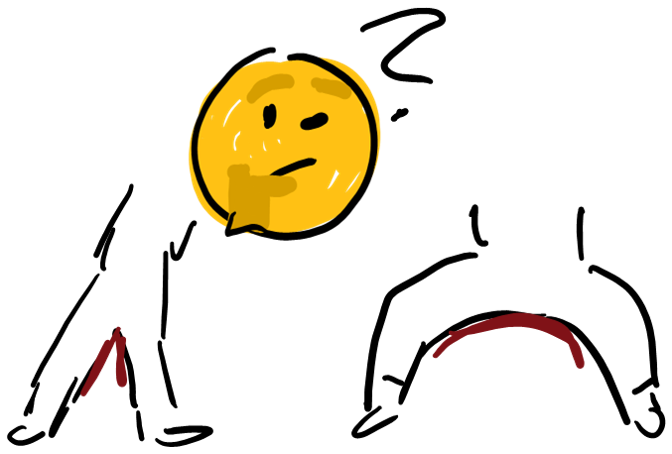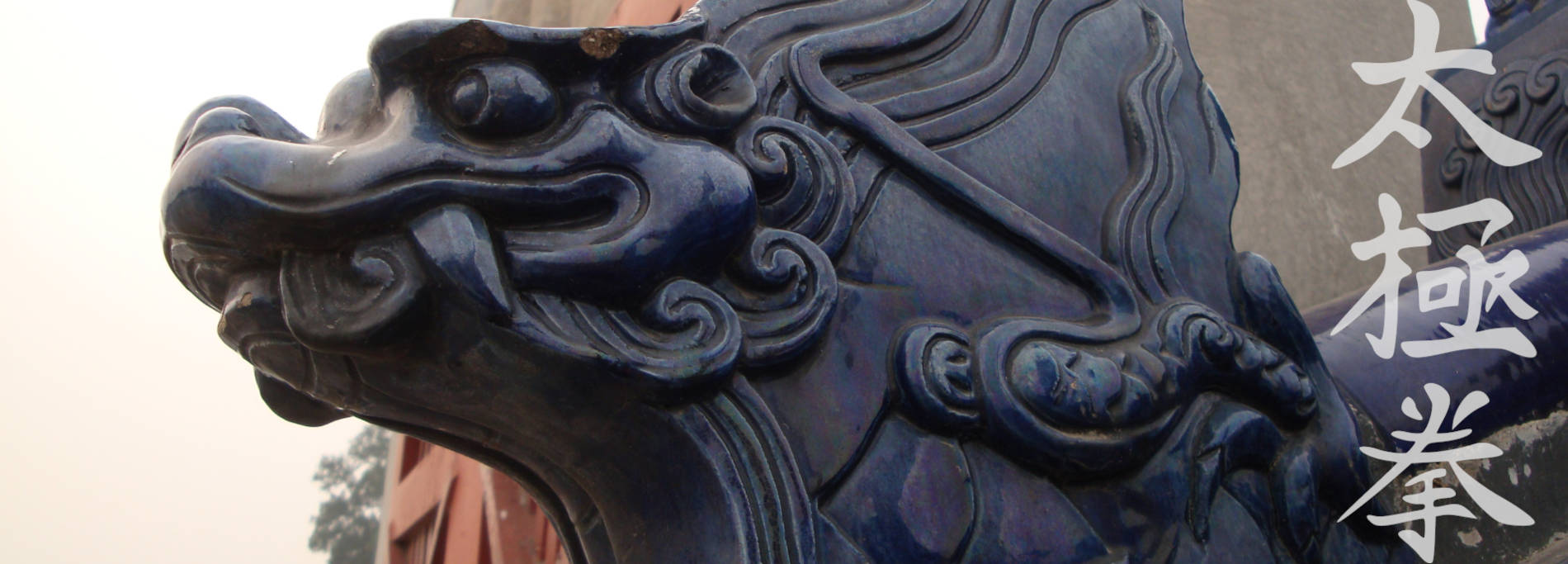 Summary: This is about communication and miscommunication when teaching Taijiquan or writing about (internal) martial arts. Also how language and concepts (proverbs and such) shape our practice, how we can relate to that while learning or teaching the arts and how to separate, connect and integrate your body experience and hone skills.
Summary: This is about communication and miscommunication when teaching Taijiquan or writing about (internal) martial arts. Also how language and concepts (proverbs and such) shape our practice, how we can relate to that while learning or teaching the arts and how to separate, connect and integrate your body experience and hone skills.
Some years ago a friend and colleague wrote an email to me and asked me something about our stance. After some words back and forth I found out that what he described as a rounded crotch I would describe as a V-shape and vice versa. It was a strange experience as I had always thought in these matters there surely must be some consensus.
Is it a "V" or a "U" - that is the question
At another occasion I saw a discussion where someone described the silk-reeling (chansi) in Chen Taijiquan. I liked the description but when I saw the actual practice I thought that this was just waving hands and arms to me. Of course I didn't say so! But at both occasions I felt the apparent futility of communication and thought about how Ferdinand de Saussure wrote about signifié and signifiant, the signified and the signifier. What is the word we use and what is the thing we try to depict? And what happens if in a discussion the word is the same but the signified differs significantly.
Common understanding in the martial arts?
Quite often I see this in the discussions about Taijiquan and other internal martial arts. Maybe more in internal martial arts than external martial arts (if we want to use this distinction at all) as the descriptions are often kinaesthetic. Thus what is signified is more elusive than something you can point your finger to. A lot of the proverbs of old differ somewhat, and even if they don't differ, often the execution is quite different. That is where the tricky part begins. To learn the method one has to reach behind the word and get the feeling for the specified concept.
There are proverbs like "the qi sinks to dantian" 气沉丹田 which are much more elusive than the above examples. Thus they are meaningless without a proper feeling and the knowledge how to put them into action. Once you can put it into action, it is very practial however. But if you just have the signifier, just the words without the actions, it will always remain meaningless. The more elusive a content is, the more learning is based on the relationship with the teacher, on the mirroring of movements, subtle actions and so on. The more obvious or biomechanical a content is, the easier it is to link signifiant and signified and the more standardised or "objective" the contents can be. (Though my examples above seem to contradict this, even "apparently" obvious things can differ significantly :)
Taijiquan Learning Stages
When I teach I try to be aware of this and explain three stages of learning, 1st understanding something in a rational way. Without this understanding training is not self-empowered and often very unproductive. The 2nd stage is feeling it, and the 3rd is the actual skill of putting it into practice. Thus slowly a system is being developed where the methods, all learnt that way, are understood and can be trained. At some point they become very interconnected in such a way that the stance cannot be separated from the centre movement anymore, the arm spirals, the forces, the breathing and so on.
Progression in Taijiquan - Training Stages
 While every aspect of the art has to go through these learning stages, I also teach how the general development evolves by differentiation, connection and integration. If we think about it, in the beginning when we learn something we will start to differentiate it from the rest. A bit like separating the yin from the yang ;-) For example, lifting up and sinking down are two main forces in Taijiquan. Most beginners can lift their heads up, but will have to learn first how to do that correctly. And only then they can sit down, sinking. Again learning sinking correctly (not just sinking anywhere!). But often it will be one OR the other and will still be unconnected.
While every aspect of the art has to go through these learning stages, I also teach how the general development evolves by differentiation, connection and integration. If we think about it, in the beginning when we learn something we will start to differentiate it from the rest. A bit like separating the yin from the yang ;-) For example, lifting up and sinking down are two main forces in Taijiquan. Most beginners can lift their heads up, but will have to learn first how to do that correctly. And only then they can sit down, sinking. Again learning sinking correctly (not just sinking anywhere!). But often it will be one OR the other and will still be unconnected.
 After differentiating the aspects we can start so connect them with one another. So we understand, feel and finally are able to connect the lifting up and sinking down and how they relate to one another. There are many other connections which we can work on pretty much from the beginning, holding in the chest, expanding the back and such things. But there are also things more difficult to connect.
After differentiating the aspects we can start so connect them with one another. So we understand, feel and finally are able to connect the lifting up and sinking down and how they relate to one another. There are many other connections which we can work on pretty much from the beginning, holding in the chest, expanding the back and such things. But there are also things more difficult to connect.
 The next step is that we integrate these connected aspects more and more. So later we understand, feel and are able to integrate the evolving structures more and more. The integration often happens on a more biomechanical level at first but later becomes more refined and subtle, more multi-sensoric. Then these contents often relate to what one could call neigong (internal work). Though I personally teach aspects of it even in the beginning the way my shifu also does, their meaning cannot yet be completely grasped. As the structures are not yet linked up enough, these internal methods cannot yet drive the external shape. So to focus on them in the beginning does not make too much sense. The focus in the beginning and also in advanced stages should be on practical work, forces, counter-forces, body structure and so on.
The next step is that we integrate these connected aspects more and more. So later we understand, feel and are able to integrate the evolving structures more and more. The integration often happens on a more biomechanical level at first but later becomes more refined and subtle, more multi-sensoric. Then these contents often relate to what one could call neigong (internal work). Though I personally teach aspects of it even in the beginning the way my shifu also does, their meaning cannot yet be completely grasped. As the structures are not yet linked up enough, these internal methods cannot yet drive the external shape. So to focus on them in the beginning does not make too much sense. The focus in the beginning and also in advanced stages should be on practical work, forces, counter-forces, body structure and so on.
In whole this is like a spiraling process, basically endless, and we run through it more than once :) Slowly we can thus progress from what we call a basic frame practice (基础架 jichu jia) and reach an advanced frame (提高架 tigao jia) and then to acquire gongfu and build a gongfu frame (功夫架 gongfu jia). To me, most debates on the internet basically cover the first or rarely the second stage, almost never anything more advanced. There are several reasons for it - at least one of these reasons seems to be grounded in communication. It is very difficult to talk about integrated methods when we cannot agree on a simple aspect like rounding, opening or closing something. Maybe I can talk about the whole training process and how I see it in more detail in another blog post.
What are we doing? Talking, teaching, debating?
As these things are so interconnected and as some contents are elusive, I feel online discussions are tricky. I usually answer in a concise way to my students (at least I try to :) where I can discuss the different development stages and so on. But with someone not training with me I personally don't feel entitled to answer very specific questions. I have the feeling that when the definitions of the first stages (aka differentiation) are not unanimous, there is no possibility how to talk about the progression. So teaching and debating are somehow feel very different to me, the first is about explaining different stages of understanding and experiencing a progressive body method, the latter seems to be more about trying to understand different definitions of basic learning stages :)
This is a simple, and obvious example for what I mean, showing different forces:
Among these are bursting 崩 and pounding 砸 forces. If one has signifier and signified, understanding and feeling are clear, so the practice can be clear. It can evolve to cover more "esoteric" contents, starting from a very practical and martial usage.
Sieh dir diesen Beitrag auf Instagram an

